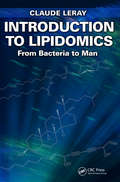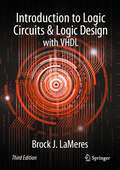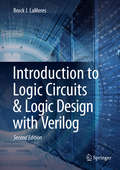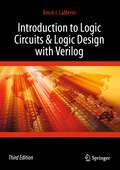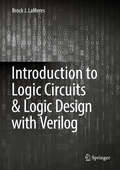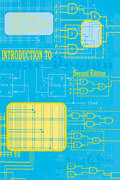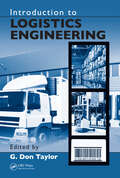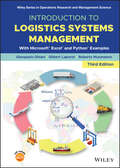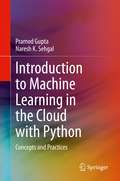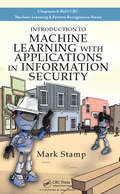- Table View
- List View
Introduction to Lipidomics: From Bacteria to Man
by Claude LerayLipidomics is the study of the lipid molecules that are found in animal, plant, and bacterial cells. Recent research in this field has been driven by the development of sensitive new mass spectrometric tools and protocols, leading to the identification and quantification of thousands of lipids and their roles in metabolic processes.Designed for stu
Introduction to Livestock and Companion Animals
by Amanda Patrick-Hefner Austin M. Bull Jim Hutter Lyle Westrom Rick RuddNIMAC-sourced textbook
Introduction to Livestock and Companion Animals
by Austin M. Bull Jasper S. Lee Jim Hutter Lyle Westrom Rick Rudd Chris Embry Mohr Jody PollockIntroduction to Livestock and Companion Animals has been revised to serve as an outstanding introductory textbook in animal science. It is about far more than cattle, swine, and chickens--though these are included. It integrates a multitude of perspectives on animal education. Basics of biology are included as the foundation for animal education. Practical connections are addressed in each chapter. Biotechnology has been expanded throughout.
Introduction to Logic Circuits & Logic Design with VHDL
by Brock J. LaMeresThis textbook introduces readers to the fundamental hardware used in modern computers. The only pre-requisite is algebra, so it can be taken by college freshman or sophomore students or even used in Advanced Placement courses in high school. This book presents both the classical approach to digital system design (i.e., pen and paper) in addition to the modern hardware description language (HDL) design approach (computer-based). This textbook enables readers to design digital systems using the modern HDL approach while ensuring they have a solid foundation of knowledge of the underlying hardware and theory of their designs. This book is designed to match the way the material is actually taught in the classroom. Topics are presented in a manner which builds foundational knowledge before moving onto advanced topics. The author has designed the content with learning goals and assessment at its core. Each section addresses a specific learning outcome that the learner should be able to “do” after its completion. The concept checks and exercise problems provide a rich set of assessment tools to measure learner performance on each outcome. This book can be used for either a sequence of two courses consisting of an introduction to logic circuits (Chapters 1-7) followed by logic design (Chapters 8-13) or a single, accelerated course that uses the early chapters as reference material.
Introduction to Logic Circuits & Logic Design with VHDL
by Brock J. LaMeresThis textbook introduces readers to the fundamental hardware used in modern computers. The only pre-requisite is algebra, so it can be taken by college freshman or sophomore students or even used in Advanced Placement courses in high school. This book presents both the classical approach to digital system design (i.e., pen and paper) in addition to the modern hardware description language (HDL) design approach (computer-based). This textbook enables readers to design digital systems using the modern HDL approach while ensuring they have a solid foundation of knowledge of the underlying hardware and theory of their designs. This book is designed to match the way the material is actually taught in the classroom. Topics are presented in a manner which builds foundational knowledge before moving onto advanced topics. The author has designed the content with learning goals and assessment at its core. Each section addresses a specific learning outcome that the learner should be able to “do” after its completion. The concept checks and exercise problems provide a rich set of assessment tools to measure learner performance on each outcome. This book can be used for either a sequence of two courses consisting of an introduction to logic circuits (Chapters 1-7) followed by logic design (Chapters 8-14) or a single, accelerated course that uses the early chapters as reference material.
Introduction to Logic Circuits & Logic Design with Verilog
by Brock J. LaMeresThis textbook for courses in Digital Systems Design introduces students to the fundamental hardware used in modern computers. Coverage includes both the classical approach to digital system design (i.e., pen and paper) in addition to the modern hardware description language (HDL) design approach (computer-based). Using this textbook enables readers to design digital systems using the modern HDL approach, but they have a broad foundation of knowledge of the underlying hardware and theory of their designs. This book is designed to match the way the material is actually taught in the classroom. Topics are presented in a manner which builds foundational knowledge before moving onto advanced topics. The author has designed the presentation with learning goals and assessment at its core. Each section addresses a specific learning outcome that the student should be able to “do” after its completion. The concept checks and exercise problems provide a rich set of assessment tools to measure student performance on each outcome.
Introduction to Logic Circuits & Logic Design with Verilog
by Brock J. LaMeresThis textbook for courses in Digital Systems Design introduces students to the fundamental hardware used in modern computers. Coverage includes both the classical approach to digital system design (i.e., pen and paper) in addition to the modern hardware description language (HDL) design approach (computer-based). Using this textbook enables readers to design digital systems using the modern HDL approach, but they have a broad foundation of knowledge of the underlying hardware and theory of their designs. This book is designed to match the way the material is actually taught in the classroom. Topics are presented in a manner which builds foundational knowledge before moving onto advanced topics. The author has designed the presentation with learning goals and assessment at its core. Each section addresses a specific learning outcome that the student should be able to “do” after its completion. The concept checks and exercise problems provide a rich set of assessment tools to measure student performance on each outcome.
Introduction to Logic Circuits & Logic Design with Verilog
by Brock J. LameresThis textbook for courses in Digital Systems Design introduces students to the fundamental hardware used in modern computers. Coverage includes both the classical approach to digital system design (i. e. , pen and paper) in addition to the modern hardware description language (HDL) design approach (computer-based). Using this textbook enables readers to design digital systems using the modern HDL approach, but they have a broad foundation of knowledge of the underlying hardware and theory of their designs. This book is designed to match the way the material is actually taught in the classroom. Topics are presented in a manner which builds foundational knowledge before moving onto advanced topics. The author has designed the presentation with learning Goals and assessment at its core. Each section addresses a specific learning outcome that the student should be able to "do" after its completion. The concept checks and exercise problems provide a rich set of assessment tools to measure student performance on each outcome.
Introduction to Logic Design
by Svetlana N. Yanushkevich Vlad P. ShmerkoWith an abundance of insightful examples, problems, and computer experiments, Introduction to Logic Design provides a balanced, easy-to-read treatment of the fundamental theory of logic functions and applications to the design of digital devices and systems. Requiring no prior knowledge of electrical circuits or electronics, it supplies the
Introduction to Logic Design (Second Edition)
by Sajjan G. ShivaThe second edition of this text provides an introduction to the analysis and design of digital circuits at a logic, instead of electronics, level. It covers a range of topics, from number system theory to asynchronous logic design. A solution manual is available to instructors only. Requests must be made on official school stationery.
Introduction to Logistics Engineering
by G. Don TaylorDespite its importance, logistics engineering often lags industry requirements, especially in terms of engineering-based needs. Filling the gap between education and practice, this brief but comprehensive volume covers the most basic material in the field of logistics engineering, making is suitable for those who require an overview of the topic. T
Introduction to Logistics Systems Management
by Roberto Musmanno Gianpaolo Ghiani Gilbert LaporteIntroduction to Logistics Systems Management is the fully revised and enhanced version of the 2004 prize-winning textbook Introduction to Logistics Systems Planning and Control, used in universities around the world.This textbook offers an introduction to the methodological aspects of logistics systems management and is based on the rich experience of the authors in teaching, research and industrial consulting.This new edition puts more emphasis on the organizational context in which logistics systems operate and also covers several new models and techniques that have been developed over the past decade.Each topic is illustrated by a numerical example so that the reader can check his or her understanding of each concept before moving on to the next one. At the end of each chapter, case studies taken from the scientific literature are presented to illustrate the use of quantitative methods for solving complex logistics decision problems. An exhaustive set of exercises is also featured at the end of each chapter.The book targets an academic as well as a practitioner audience, and is appropriate for advanced undergraduate and graduate courses in logistics and supply chain management, and should also serve as a methodological reference for practitioners in consulting as well as in industry.
Introduction to Logistics Systems Management: With Microsoft Excel and Python Examples (Wiley Series in Operations Research and Management Science)
by Roberto Musmanno Gianpaolo Ghiani Gilbert LaporteINTRODUCTION TO LOGISTICS SYSTEMS MANAGEMENT The updated new edition of the award-winning introductory textbook on logistics system management Introduction to Logistics Systems Management provides an in-depth introduction to the methodological aspects of planning, organization, and control of logistics for organizations in the private, public and non-profit sectors. Based on the authors’ extensive teaching, research, and industrial consulting experience, this classic textbook is used in universities worldwide to teach students the use of quantitative methods for solving complex logistics problems. Fully updated and revised, the third edition places increased emphasis on the complexity and flexibility required by modern logistics systems. In this context, the extensive use of data, descriptive analytics, predictive models, and optimization techniques will be invaluable to support the decisions and actions of logistics and supply chain managers. Throughout the book, brand-new case studies and numerical examples illustrate how various methods can be used in industrial and service logistics to reduce costs and improve service levels. The book: includes new models and techniques that have emerged over the past decade; describes methodologies for logistics decision making, forecasting, logistics system design, procurement, warehouse management, and freight transportation management; includes end-of-chapter exercises, Microsoft® Excel® files and Python® computer codes for each algorithm covered; includes access to a companion website with additional exercises, links to video tutorials, and supplementary teaching material. To facilitate creation of course material, additional LaTeX source data containing the formulae, optimization models, tables and algorithms described in the book is available to instructors. Introduction to Logistics Systems Management, Third Edition remains an essential textbook for senior undergraduate and graduate students in engineering, computer science, and management science courses. It is also a highly useful reference for academic researchers and industry practitioners alike.
Introduction to MIMO Communications
by Jerry R. HamptonThis accessible, self-contained guide contains everything you need to get up to speed on the theory and implementation of MIMO techniques. In-depth coverage of topics such as RF propagation, space-time coding, spatial multiplexing, OFDM in MIMO for broadband applications, the theoretical MIMO capacity formula and channel estimation will give you a deep understanding of how the results are obtained, while detailed descriptions of how MIMO is implemented in commercial WiFi and LTE networks will help you apply the theory to practical wireless systems. Key concepts in matrix mathematics and information theory are introduced and developed as you need them, and key results are derived step-by-step, with no details omitted. Including numerous worked examples, and end-of-chapter exercises to reinforce and solidify your understanding, this is the perfect introduction to MIMO for anyone new to the field.
Introduction to Machine Learning in the Cloud with Python: Concepts and Practices
by Pramod Gupta Naresh K. SehgalThis book provides an introduction to machine learning and cloud computing, both from a conceptual level, along with their usage with underlying infrastructure. The authors emphasize fundamentals and best practices for using AI and ML in a dynamic infrastructure with cloud computing and high security, preparing readers to select and make use of appropriate techniques. Important topics are demonstrated using real applications and case studies.
Introduction to Machine Learning with Applications in Information Security
by Mark Stamp<p>Introduction to Machine Learning with Applications in Information Security provides a class-tested introduction to a wide variety of machine learning algorithms, reinforced through realistic applications. The book is accessible and doesn’t prove theorems, or otherwise dwell on mathematical theory. The goal is to present topics at an intuitive level, with just enough detail to clarify the underlying concepts. <p>The book covers core machine learning topics in-depth, including Hidden Markov Models, Principal Component Analysis, Support Vector Machines, and Clustering. It also includes coverage of Nearest Neighbors, Neural Networks, Boosting and AdaBoost, Random Forests, Linear Discriminant Analysis, Vector Quantization, Naive Bayes, Regression Analysis, Conditional Random Fields, and Data Analysis. <p>Most of the examples in the book are drawn from the field of information security, with many of the machine learning applications specifically focused on malware. The applications presented are designed to demystify machine learning techniques by providing straightforward scenarios. Many of the exercises in this book require some programming, and basic computing concepts are assumed in a few of the application sections. However, anyone with a modest amount of programming experience should have no trouble with this aspect of the book. <p>Instructor resources, including PowerPoint slides, lecture videos, and other relevant material are provided on an accompanying website: http://www.cs.sjsu.edu/~stamp/ML/. For the reader’s benefit, the figures in the book are also available in electronic form, and in color.
Introduction to Machine Learning with Security: Theory and Practice Using Python in the Cloud (Synthesis Lectures on Engineering, Science, and Technology)
by Naresh Kumar Sehgal Pramod Gupta John M. AckenThis book provides an introduction to machine learning, security and cloud computing, from a conceptual level, along with their usage with underlying infrastructure. The authors emphasize fundamentals and best practices for using AI and ML in a dynamic infrastructure with cloud computing and high security, preparing readers to select and make use of appropriate techniques. Important topics are demonstrated using real applications and case studies.
Introduction to Magnetic Random-Access Memory
by Bernard Dieny Kyung-Jin Lee Ronald B. GoldfarbMagnetic random-access memory (MRAM) is poised to replace traditional computer memory based on complementary metal-oxide semiconductors (CMOS). MRAM will surpass all other types of memory devices in terms of nonvolatility, low energy dissipation, fast switching speed, radiation hardness, and durability. Although toggle-MRAM is currently a commercial product, it is clear that future developments in MRAM will be based on spin-transfer torque, which makes use of electrons' spin angular momentum instead of their charge. MRAM will require an amalgamation of magnetics and microelectronics technologies. However, researchers and developers in magnetics and in microelectronics attend different technical conferences, publish in different journals, use different tools, and have different backgrounds in condensed-matter physics, electrical engineering, and materials science. This book is an introduction to MRAM for microelectronics engineers written by specialists in magnetic materials and devices. It presents the basic phenomena involved in MRAM, the materials and film stacks being used, the basic principles of the various types of MRAM (toggle and spin-transfer torque; magnetized in-plane or perpendicular-to-plane), the back-end magnetic technology, and recent developments toward logic-in-memory architectures. It helps bridge the cultural gap between the microelectronics and magnetics communities.
Introduction to Magnetism and Magnetic Materials
by David JilesA long overdue update, this edition of Introduction to Magnetism and Magnetic Materials is a complete revision of its predecessor. While it provides relatively minor updates to the first two sections, the third section contains vast updates to reflect the enormous progress made in applications in the past 15 years, particularly in magnetic recordin
Introduction to Maintenance Engineering: Modelling, Optimization and Management
by D. N. Murthy Mohamed Ben-Daya Uday KumarThis introductory textbook links theory with practice using real illustrative cases involving products, plants and infrastructures and exposes the student to the evolutionary trends in maintenance. Provides an interdisciplinary approach which links, engineering, science, technology, mathematical modelling, data collection and analysis, economics and management Blends theory with practice illustrated through examples relating to products, plants and infrastructures Focuses on concepts, tools and techniques Identifies the special management requirements of various engineered objects (products, plants, and infrastructures)
Introduction to Manufacturing Processes and Materials (Manufacturing Engineering and Materials Processing #Vol. 54)
by Robert CreeseThe first manufacturing book to examine time-based break-even analysis, this landmark reference/text applies cost analysis to a variety of industrial processes, employing a new, problem-based approach to manufacturing procedures, materials, and management. An Introduction to Manufacturing Processes and Materials integrates analysis of material costs and process costs, yielding a realistic, effective approach to planning and executing efficient manufacturing schemes. It discusses tool engineering, particularly in terms of cost for press work, forming dies, and casting patterns, process parameters such as gating and riser design for casting, feeds, and more.
Introduction to Manufacturing: An Industrial Engineering and Management Perspective
by Michel Baudin Torbjørn NetlandThis Introduction to Manufacturing focuses students on the issues that matter to practicing industrial engineers and managers. It offers a systems perspective on designing, managing, and improving manufacturing operations. On each topic, it covers the key issues, with pointers on where to dig deeper. Unlike the many textbooks on operations management, supply chain management, and process technology, this book weaves together these threads as they interact in manufacturing. It has five parts: Getting to Know Manufacturing: Fundamental concepts of manufacturing as an economic activity, from manufacturing strategy to forecasting market demand Engineering the Factory: Physical design of factories and processes, the necessary infrastructure and technology for manufacturing Making Information Flow: The "central nervous system" that triggers and responds to events occurring in production Making Materials Flow: The logistics of manufacturing, from materials handling inside the factory via warehousing to supply chain management Enhancing Performance: Managing manufacturing performance and methods to maintain and improve it, both in times of normal operations and emergencies Supported with rich illustrations and teaching aids, Introduction to Manufacturing is essential reading for industrial engineering and management students – of all ages and backgrounds – engaged in the vital task of making the things we all use.
Introduction to Materials Chemistry
by Harry R. AllcockThis textbook introduces the reader to the elementary chemistry on which materials science depends by discussing the different classes of materials and their applications. It shows the reader how different types of materials are produced, why they possess specific properties, and how they are used in technology. Each chapter contains study questions to enable discussions and consolidation of the acquired knowledge. The new edition of this textbook is completely revised and updated to reflect the significant expansion of the field of materials chemistry over the last years, covering now also topics such as graphene, nanotubes, light emitting diodes, extreme photolithography, biomedical materials, and metal organic frameworks. From the reviews of the first edition: "This book is not only informative and comprehensive for a novice reader, but also a valuable resource for a scientist and/or an industrialist for new and novel challenges." (Materials and Manufacturing Process, June 2009) "Allcock provides a clear path by first describing basic chemical principles, then distinguishing between the various major materials groups, and finally enriching the student by offering a variety of special examples." (CHOICE, April 2009) "Proceeding logically from the basics to materials in advanced technology, it covers the fundamentals of materials chemistry, including principles of materials synthesis and materials characterization methods." (Internationale Fachzeitschrift Metall, January 2009)
Introduction to Materials Chemistry
by Harry R. AllcockIntroduction to Materials Chemistry will appeal to advanced undergraduates and graduate students in chemistry, materials science,and chemical engineering by leading them stepwise from the elementary chemistry on which materials science depends, through a discussion of the different classes of materials, and ending with a description of how materials are used in devices and general technology.
Introduction to Materials Science and Engineering
by Yip-Wah Chung Monica KapoorOur civilization owes its most significant milestones to our use of materials. Metals gave us better agriculture and eventually the industrial revolution, silicon gave us the digital revolution, and we’re just beginning to see what nanomaterials yield. Updated to reflect the many societal and technological changes in the field since publication of the first edition, Introduction to Materials Science and Engineering, Second Edition, offers an interdisciplinary view that emphasizes the importance of materials to engineering applications and builds the basis needed to select, modify, and create materials to meet specific criteria. The most outstanding feature of this book is the authors’ unique and engaging application-oriented approach. By beginning each chapter with a real-life example, an experiment, or interesting facts, the authors wield an expertly crafted treatment that entertains and motivates as much as informs and educates. The discipline is linked to modern developments, such as semiconductor devices, nanomaterials, and thin films, while working systematically from atomic bonding and analytical methods to crystalline, electronic, mechanical, and magnetic properties as well as ceramics, polymers, corrosion, and phase diagrams. Updates in the Second Edition References to advances in the field, including computational thermodynamics, allowing computation of phase diagrams with great accuracy and new materials Updated applications and technologies, such as electric vehicles and the use of magnetic fields as a processing tool Revised, practical end-of-chapter problems that go beyond traditional plug-and-chug exercises to enhance learning More examples with detailed solutions in each chapter A new chapter highlighting how materials can impact four United Nations Sustainable Development Goals This book is written for undergraduate students and readers interested in introductory materials science and engineering concepts. This concise textbook provides a strong foundation in materials science engineering and its applications. A solutions manual and PowerPoint lecture slides are available for adopting professors.
